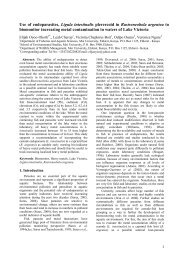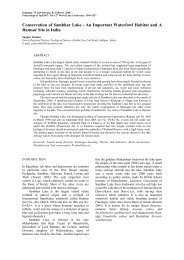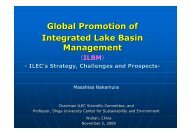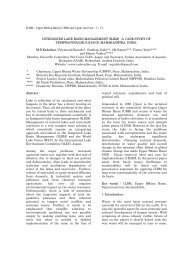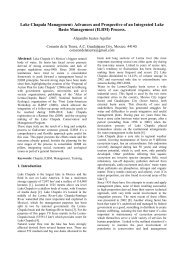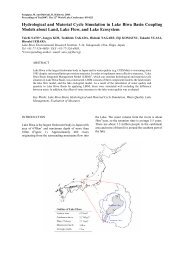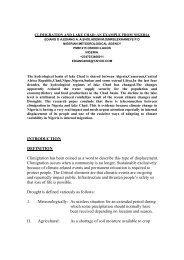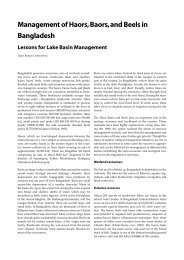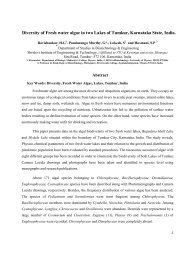Institutional Coordination and Policy Development in Lake Basin ...
Institutional Coordination and Policy Development in Lake Basin ...
Institutional Coordination and Policy Development in Lake Basin ...
Create successful ePaper yourself
Turn your PDF publications into a flip-book with our unique Google optimized e-Paper software.
<strong>Institutional</strong><br />
<strong>Coord<strong>in</strong>ation</strong> <strong>and</strong> <strong>Policy</strong><br />
<strong>Development</strong> <strong>in</strong> <strong>Lake</strong><br />
Bas<strong>in</strong> Management:<br />
Lessons from the<br />
Chilika lake, India<br />
A.K. PATTNAIK,Ph.D.
I N D I A<br />
Salient features of Chilika <strong>Lake</strong><br />
Length - 64 kms (max)<br />
Breadth - 20 kms (max)<br />
Avg. water spread area - 1065 sq. km<br />
Depth - 0.38 to 4.2 m<br />
Catchment area - 4406 sq kms<br />
No. of fishermen villages - 192<br />
Total fisher folk - 0.2 million<br />
Chilika <strong>Lake</strong><br />
B a y o f B e n g a l
Management issues:<br />
• Complex ecosystem<br />
• Multitude stakeholders (Open use of<br />
lake resources without any<br />
<strong>in</strong>stitutional regulatory mechanisms).<br />
• Change <strong>in</strong> hydrological regime due to<br />
alteration of flow<br />
• Shr<strong>in</strong>kage of water spread area of<br />
the <strong>Lake</strong> due to siltation <strong>and</strong> poor<br />
flush<strong>in</strong>g.<br />
• Loss of biodiversity <strong>and</strong> productivity.<br />
• Degradation of the life support system,<br />
<strong>in</strong> the lagoon <strong>and</strong> the dra<strong>in</strong>age bas<strong>in</strong><br />
• Included <strong>in</strong> the Montreux record <strong>in</strong><br />
1993 due to change <strong>in</strong> its ecological<br />
characters.<br />
Shr<strong>in</strong>kage of water spread Area (1972 – 2001)<br />
8000<br />
7000<br />
6000<br />
5000<br />
4000<br />
3000<br />
2000<br />
1000<br />
0<br />
Chilika Lagoon<br />
1985<br />
1972 - 73 (824 sq.km)<br />
FISH LANDING (MT)<br />
Chilika Lagoon<br />
2001 (790 sq km)<br />
Decrease <strong>in</strong> fish l<strong>and</strong><strong>in</strong>g<br />
1999<br />
1985-86<br />
1986-87<br />
1987-88<br />
1988-89<br />
1989-90<br />
1990-91<br />
1991-92<br />
1992-93<br />
1993-94<br />
1994-95<br />
1995-96<br />
1996-97<br />
1997-98<br />
1998-99
GOVERNING BODY OF CDA<br />
CHAIRMAN (CHIEF MINISTER)<br />
WORKING CHAIRMAN (MINISTER, ENV)<br />
MEMBERS<br />
LOCAL REPRESENTATIVES, SECRETARIES FROM KEY DEPARTMENTS,<br />
EXPERTS FROM PREMIER INSTITUTES, REPRESENTATIVE FROM<br />
FISHERMEN FEDERATION.
Restoration strategy<br />
Wide stakeholder consultation.<br />
Key targeted studies to underst<strong>and</strong><br />
the complex ecosystem <strong>and</strong> to trace<br />
out the root cause of degradation.<br />
Connect science to the social values,<br />
<strong>in</strong>stitutions <strong>and</strong> ethos of local<br />
community.<br />
Adaptive management plann<strong>in</strong>g based<br />
on science.<br />
Ecosystem approach to restore the<br />
ecological <strong>in</strong>tegrity <strong>and</strong> functionality<br />
of the lake through wide consultative<br />
process.<br />
Integration of the watershed <strong>in</strong> the<br />
management of the lake with micro<br />
watershed as a functional ecological<br />
unit with facilitation of community level<br />
<strong>in</strong>stitution to manage the resources.<br />
Strong <strong>in</strong>stitutional coord<strong>in</strong>ation <strong>and</strong><br />
strategic partnership.
Successive adaptive plann<strong>in</strong>g<br />
The first phase <strong>in</strong>cluded the;<br />
restoration of the lake by reestablish<strong>in</strong>g<br />
the flow regime with<br />
the Bay of Bengal, pilot project for<br />
micro-watershed management<br />
with capacity build<strong>in</strong>g <strong>and</strong><br />
empowerment of the resource<br />
users through facilitation of the<br />
grass root level <strong>in</strong>stitutions.<br />
In next phase the pilot project upscaled<br />
to some 13 more microwatersheds<br />
<strong>in</strong> the dra<strong>in</strong>age bas<strong>in</strong>.<br />
It is envisaged to exp<strong>and</strong> the<br />
management to the River bas<strong>in</strong><br />
scale.
A Strategic Process Adopted for Restoration<br />
Formal adoption<br />
<strong>and</strong> fund<strong>in</strong>g<br />
Implementation<br />
Progressive spiral of growth of the Project<br />
4<br />
5<br />
M & Evaluation<br />
3<br />
Stake holder<br />
Consultation &<br />
plann<strong>in</strong>g<br />
<strong>Lake</strong> & Coast<br />
Devt. <strong>Institutional</strong> mechns.<br />
Issue identification <strong>and</strong><br />
assessment<br />
1<br />
2<br />
4<br />
Time<br />
5<br />
3<br />
2<br />
4<br />
Watershed River Bas<strong>in</strong><br />
1<br />
5<br />
3<br />
2<br />
1
<strong>Lake</strong> Watershed<br />
Badasankha R.<br />
9<br />
JanjiraR.<br />
8<br />
Kansari R.<br />
7<br />
Kusumi R.<br />
6<br />
CHILIKA LAGOON<br />
Western Catchment<br />
Makara R.<br />
4<br />
Daya R.<br />
3<br />
1<br />
Bhargavi R.<br />
Mahanadi Delta<br />
2<br />
Nuna R<br />
Kuakhai R.<br />
Mahanadi River<br />
B A Y O F B E N G A L<br />
Mundali Barrage<br />
Alteration of Flow<br />
Naraj Weir<br />
Kuakhai R.<br />
Khushbhadrai R.<br />
Kathjori R.<br />
Kathjori R.<br />
Mahanadi R.<br />
Devi R.<br />
Mahanadi<br />
Barrage<br />
Birupa<br />
Barrage
<strong>Institutional</strong> L<strong>in</strong>kages<br />
of Chilika <strong>Development</strong><br />
Authority<br />
COMMUNITY LEVEL<br />
INSTITUTIONS<br />
•Fishermen Cooperative Societies<br />
•Watershed Associations<br />
•Self Help Groups<br />
RESEARCH INSTITUTIONS<br />
•Central Water & Power Research<br />
Station<br />
•National Institute of Oceanography<br />
•IIT Chennai<br />
•Zoological Survey of <strong>in</strong>dia<br />
•Botanical survey of India<br />
•Wildlife Institute of India<br />
•National Remote Sens<strong>in</strong>g Agency<br />
•Bombay natural history Society<br />
•Central Institute for Brackish Water<br />
Fishery<br />
INTERNATIONAL ORGANISATIONS<br />
•Ramsar Secretariat<br />
•Wetl<strong>and</strong>s <strong>in</strong>ternational<br />
•World bank<br />
•JICA<br />
•ILEC<br />
•Danish Embassy<br />
•DHI<br />
•Ramsar Center Japan<br />
•Tokyo University<br />
-<br />
CHILIKA<br />
DEVELOPMENT<br />
AUTHORITY<br />
NONGOVERNMENTAL ORGANISATIONS<br />
•Campaign for Conservation of Chilika<br />
Lagoon (CCCL)<br />
•20 local NGOs <strong>and</strong> CBOs<br />
NATIONAL ORGANISATIONS<br />
•M<strong>in</strong>istry of Environment ,Agriculture,<br />
•Science <strong>and</strong> technology, Water<br />
Resources –Government of India<br />
•National Bank for Agriculture Devt.<br />
• Water Technology <strong>Development</strong> for<br />
Eastern region<br />
•Central Inl<strong>and</strong> Fishery development<br />
Center<br />
•Indian Institute of Tourism <strong>and</strong> travel<br />
management<br />
LOCAL ORGANISATIONS<br />
• Fishery <strong>and</strong> Animal Resource<br />
<strong>Development</strong> Department<br />
•Water resources Department<br />
•Forest Department<br />
•Revenue Department<br />
•Science <strong>and</strong> Technology Department<br />
•Agriculture Department<br />
•Remote Sens<strong>in</strong>g Application Center<br />
•Watershed Mission<br />
•Renewable Energy <strong>Development</strong><br />
Center
Improvement after hydrological <strong>in</strong>tervention<br />
•Eight fold <strong>in</strong>crease <strong>in</strong> annual fish <strong>and</strong><br />
prawn l<strong>and</strong><strong>in</strong>g<br />
•Avg. <strong>in</strong>crease of <strong>in</strong>come of fishermen by<br />
1000 US$ per annum after open<strong>in</strong>g of the<br />
new mouth.<br />
•Increase <strong>in</strong> sal<strong>in</strong>ity flux by 40%<br />
•Increase <strong>in</strong> tidal flux by 45%<br />
•Improvement of sediment flush<strong>in</strong>g<br />
•Quick discharge of flood water<br />
•Decrease of <strong>in</strong>vasive species by 162 sq<br />
km<br />
Chilika Lagoon<br />
Old Mouth<br />
New Mouth<br />
BAY OF BENGAL<br />
Open<strong>in</strong>g of the New Mouth
<strong>Lake</strong> bas<strong>in</strong> Scenario<br />
Assessment revealed that l<strong>and</strong><br />
degradation <strong>in</strong> the dra<strong>in</strong>age bas<strong>in</strong><br />
resulted <strong>in</strong> enhanced silt flow <strong>in</strong>to<br />
the lagoon <strong>and</strong> triggered poverty,<br />
due to low productivity.<br />
The depletion of natural resources<br />
<strong>and</strong> loss of their productive capacity<br />
had imparted huge cost on the local<br />
communities.<br />
The poor were the first <strong>and</strong> most<br />
directly <strong>and</strong> adversely impacted due<br />
to l<strong>and</strong> degradation result<strong>in</strong>g <strong>in</strong><br />
decl<strong>in</strong><strong>in</strong>g agricultural productivity.
Participatory management of watershed with a “susta<strong>in</strong>able<br />
rural livelihood” approach.<br />
The dra<strong>in</strong>age bas<strong>in</strong> of the lagoon that<br />
spreads over 4000 square kilometres<br />
was the logical start<strong>in</strong>g po<strong>in</strong>t for<br />
management actions of the lagoon.<br />
The environmental flow assessment<br />
provided necessary clues regard<strong>in</strong>g the<br />
significance of the freshwater flow from<br />
the dra<strong>in</strong>age bas<strong>in</strong> to ma<strong>in</strong>ta<strong>in</strong> the<br />
ecological <strong>in</strong>tegrity of the lagoon.<br />
The large-scale silt flow from<br />
catchments (0.4 million cubic meters)<br />
was identified as the most detrimental<br />
for the lake ecosystem.
Contd…<br />
The dra<strong>in</strong>age bas<strong>in</strong> management<br />
programme is conceived as a longterm<br />
participatory process to achieve<br />
an environmentally, economically<br />
<strong>and</strong> socially susta<strong>in</strong>able<br />
management of water resources.<br />
The basic approach adopted has been<br />
to facilitate <strong>and</strong> create an enabl<strong>in</strong>g<br />
environment, through capacity<br />
build<strong>in</strong>g of the community,<br />
community based organisations<br />
<strong>and</strong> NGOs to develop strong <strong>and</strong><br />
efficient grass root level<br />
<strong>in</strong>stitutions.<br />
Community level <strong>in</strong>stitutions <strong>and</strong><br />
equity issue were made central to<br />
the Integrated Watershed<br />
Management.
Watershed Association (Watershed level <strong>in</strong>stitutions for<br />
susta<strong>in</strong>able management of resources)<br />
Watershed Association at each<br />
micro watershed are the key<br />
<strong>in</strong>stitutions to mange the natural<br />
resources <strong>and</strong> ensure equitable<br />
distribution of the benefits.<br />
All adults from the micro-watershed<br />
villages are members of the<br />
watershed association.<br />
The general body of the association<br />
constitute a draft<strong>in</strong>g committee to draft<br />
the by-laws.<br />
The watershed association then<br />
constitutes the watershed committee<br />
with fair representation from the<br />
l<strong>and</strong>less, socially weaker section <strong>and</strong><br />
adequate women representatives.<br />
The watershed associations are also<br />
registered under Societies of<br />
Registration Act.
Micro plann<strong>in</strong>g (Village level resource management plan)<br />
The micro-plan for each micro<br />
watershed formulated blended with<br />
local <strong>in</strong>digenous knowledge <strong>and</strong><br />
appropriate experts’ <strong>in</strong>put, for optimum<br />
utilization of the natural resources <strong>in</strong> a<br />
susta<strong>in</strong>able manner .<br />
To ensure the <strong>in</strong>volvement of the<br />
community <strong>and</strong> susta<strong>in</strong>ability, the<br />
committee ensures that the community<br />
share a part of the cost of the treatment<br />
towards the watershed development<br />
fund which is utilised for ma<strong>in</strong>tenance<br />
<strong>and</strong> further improvement of the<br />
watershed assets created .<br />
The watershed association <strong>and</strong> the<br />
user groups has been able to<br />
efficiently implement the micro-plan <strong>in</strong><br />
consultation with the community.
Women Participation<br />
The Watershed Association takes the<br />
lead <strong>in</strong> <strong>in</strong>tegrat<strong>in</strong>g women from all<br />
communities <strong>in</strong>to the ma<strong>in</strong>stream by way<br />
of empowerment through Self Help<br />
Groups <strong>and</strong> their active participation <strong>in</strong><br />
the watershed management.<br />
The women of the community benefited <strong>in</strong><br />
a special way through the formation of the<br />
women self-help groups (SHG) <strong>and</strong><br />
capacity build<strong>in</strong>g tra<strong>in</strong><strong>in</strong>g for skill<br />
improvement.<br />
Through a micro-credit mechanism, the<br />
members of the SHGs adopted <strong>in</strong>comegenerat<strong>in</strong>g<br />
activities to supplement their<br />
family’s <strong>in</strong>come.<br />
By work<strong>in</strong>g to earn for themselves, the<br />
women empowered themselves aga<strong>in</strong>st<br />
the prevail<strong>in</strong>g social taboo, now they are<br />
better placed to take the decision on<br />
f<strong>in</strong>ancial matter
Conflict resolution<br />
The WA could very effectively<br />
resolve the longst<strong>and</strong><strong>in</strong>g village<br />
level social conflicts <strong>and</strong> differences<br />
of op<strong>in</strong>ions with<strong>in</strong> the micro-<br />
watershed area .<br />
Even the chronic <strong>in</strong>ter-village<br />
conflict plagu<strong>in</strong>g these non-<br />
descript villages for the many years<br />
could be resolved amicably by the<br />
this local level <strong>in</strong>stitutions.<br />
The micro-watershed <strong>in</strong>stitutions<br />
became the model <strong>in</strong> the context of<br />
social <strong>in</strong>tegration.
Good practices by watershed <strong>in</strong>stitution<br />
Participatory management of the watershed with facilitation of<br />
strong grass root level <strong>in</strong>stitutions; resulted <strong>in</strong> enhancement of<br />
productivity <strong>and</strong> poverty alleviation by efficient management <strong>and</strong><br />
equitable shar<strong>in</strong>g of natural resources .<br />
Participation of local communities <strong>in</strong> plann<strong>in</strong>g <strong>and</strong> implement<strong>in</strong>g<br />
management of natural resources <strong>and</strong> <strong>in</strong> shar<strong>in</strong>g the<br />
responsibilities of decision-mak<strong>in</strong>g has been key to the success.<br />
The project is an ecological success <strong>in</strong> many respects, notably, there<br />
have been <strong>in</strong>creased earn<strong>in</strong>gs from l<strong>and</strong> <strong>and</strong> non-l<strong>and</strong> activities,<br />
reduced debt, conflict resolution <strong>and</strong> social <strong>in</strong>tegration <strong>and</strong><br />
improved livelihood <strong>and</strong> food security lead<strong>in</strong>g to further poverty<br />
alleviation, reduced environmental degradation <strong>and</strong> reduction <strong>in</strong> the<br />
silt load <strong>in</strong>to the lagoon.<br />
The local community now lives <strong>in</strong> harmony, as is evident from a quote<br />
by villagers: “we are now an extended watershed family <strong>and</strong> there<br />
is no question of discrim<strong>in</strong>ation.”
Silver l<strong>in</strong><strong>in</strong>gs<br />
Instill<strong>in</strong>g stakeholders participation <strong>and</strong> facilitation of village level<br />
<strong>in</strong>stitutions, i.e., from the problem identification stage to the<br />
restoration <strong>and</strong> management of the natural resources through<br />
capacity development <strong>and</strong> empowerment by way of local level<br />
<strong>in</strong>stitutions .<br />
Work<strong>in</strong>g with<strong>in</strong> exist<strong>in</strong>g sectors <strong>and</strong> overcom<strong>in</strong>g the barriers that<br />
exist across; through successful strategic partnership.<br />
The capacity development <strong>and</strong> empowerment of the local<br />
community, community level <strong>in</strong>stitutions <strong>and</strong> the local NGOs<br />
created an enabl<strong>in</strong>g environment for susta<strong>in</strong>able restoration <strong>and</strong><br />
management of the lake <strong>and</strong> watershed resources.<br />
Creat<strong>in</strong>g participatory management <strong>in</strong>stitutions (<strong>in</strong>clud<strong>in</strong>g local<br />
people <strong>and</strong> NGOs) at the grass root level with a legal status, with<br />
a m<strong>and</strong>ate, accountability to make decisions .



